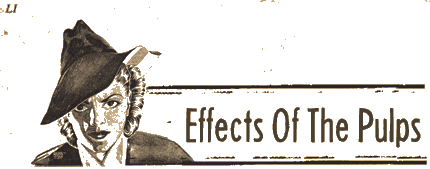
"After 12,000 Years"
The Effects of the Pulps on Present-Day Culture
With the passage of the Fulton Act in 1949, the pulps' subject matter had been outlawed by Parliament. As the 1950s dawned, their medium had been outmoded by the more dynamic formats of film and television. Their pages yellowing and their screaming story titles muted, the pulps disappeared from the public consciousness.
But the elements that had made them so popular lived on in other forms. The sensationalist impulses that animated the pulps are recognizable today in tabloid television and newspapers that tease readers and viewers with promises of lurid details of scandalous crimes, and manufacture melodrama from the love lives of celebrities.
Paperback romance novels are the new repository of the doomed-love or against-all-odds love stories that were the stock-in-trade of the romance pulps. It is a lineage that can be traced quite directly in Canada, where Harlequin, probably the largest publishers of romance literature in the world, bought and integrated the romance libraries of such pulp publishers as Bouregy and Curl Inc.
Although they no longer dominate shelf space, a trip to a specialty magazine shop will reveal that true crime and love confession periodicals are still published. Provisions of the Criminal Code notwithstanding, their content is more frank and explicit than anything the pulp publishers would have dreamed of printing. Books are still published on the subjects of high-profile criminals, such as Stephen Reid, one-time leader of the bank-robbing "Stopwatch Gang" (Strange and Loo 2004, p. 102) and the Hells Angels and Rock Machine biker gangs. A pulp story in progress also forms a large part of the narrative of Margaret Atwood's recent novel The Blind Assassin.
True-crime stories make for popular television as well. Whereas in the past the pulps would have been the medium of choice, today Canadians are more likely to consume their true crime in the form of made-for-television movies such as the CBC productions The Boys of St. Vincent, Butterbox Babies, The Helen Betty Osborne Story, The David Milgaard Story and Love and Hate (Strange and Loo 2004, p. 99). Alongside these small-screen features, writers of Canadian television shows such as Blue Murder, Cold Squad and DaVinci's Inquest all make use of ripped-from-the-headlines stories for their plots. And for a modern twist on the Mounties of the pulps' "northerns," you need look no further than Constable Benton Frasier of television's Due South.
Beyond the living room, the legacy of the pulps finds expression in low-budget Canadian horror films such as Shivers, Rabid, Cannibal Girls, Black Christmas, Prom Night, Scanners and, more recently, the Ginger Snaps series. Without big-name stars or massive promotional budgets, they depend -- just as the pulps did -- on extreme imagery and shocking subject matter to attract attention and audiences. Perhaps even more directly influenced by the pulps is writer-director John Paizs' Crime Wave (1985), a film that follows the adventures of a young man whose dream is to become a great "colour crime writer." From its idealized 1950s-esque setting to its painted poster (which resembles a pulp cover), Crime Wave (www.angelfire.com/movies/CrimeWave/) is steeped in the esthetic of the pulps.
In magazines, in books, on television and on the movie screen, the effect of the pulps is felt as strongly today as it was in the era when you could slap down 15 cents and escape to another world -- one spun of cheap paper and penny-a-word imagination.
Reference
Strange, Carolyn, and Tina Loo. True Crime, True North: the Golden Age of Canadian Pulp Magazines. Vancouver: Raincoast Books, 2004.